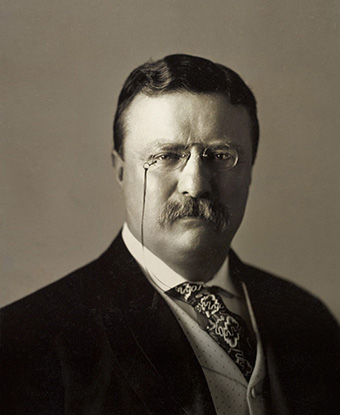Last updated: March 26, 2025
Person
Theodore Roosevelt

Library of Congress
"I never would have been President if it had not been for my experiences in North Dakota." -Theodore Roosevelt
The iconic titles Naturalist, Explorer, Author, Hunter, Cowboy, Family Man, Statesman, Rough Rider, War Hero, and President of the United States must all be invoked to accurately describe the life of Theodore Roosevelt.
Born into a wealthy family, as a child Theodore Roosevelt suffered from severe asthma. In attempts to relieve his suffering, his parents provided young "Teedie" with the best treatments available including giving him cigar smoke to inhale, black coffee to drink, and racing him down NYC streets in the family buggy to force air into his lungs. Theodore used strenuous physical activity, including exercise, to overcome his health problems.
As a young child, he was innately curious in the natural world, later stating in his book My Life as a Naturalist, "I can no more explain why I like 'natural history' than than why I like California canned peaches;...almost as soon as I began to read at all I began to like to read about the natural history of beasts and birds and the more formidable or interesting reptiles and fishes."
Roosevelt traveled widely throughout his life: Not only did he travel extensively throughout the USA, he also would take a family grand tour of Europe, and a family trip down the Nile River before his 14th birthday. Later in life, Theodore would be the first US president to leave the country, visiting the Panama Canal, and would explore a section of the Amazon River, known as The River of Doubt, after loosing the 1912 presidential election.
Theodore met his first wife, Alice Hathaway Lee while attending Harvard University. Sadly, on February 14, 1884, Theodore would loose Alice and his mother, Martha "Mittie" Roosevelt, within hours of one another. Alice died only two days after giving birth to their first child, also named Alice. Following this tragedy, Roosevelt retreated to the Dakota Territory to grieve and challenge himself by living the cowboy life. There, Roosevelt learned “the value of instant decision”, brought thieves to justice, hunted wild game, and observed the last vestiges of the bison that once dominated the plains.
Invigorated by his western experience, Roosevelt returned to his political life in New York City and remarried to a childhood sweetheart, Edith Kermit Carow. They raised five children (Theodore "Ted" Roosevelt Jr., Kermit, Ethel, Archibald, and Quentin) together as Roosevelt continued his life of public service.
In 1898, resigning from Assistant Secretary of the Navy, Roosevelt organized a volunteer cavalry, the Rough Riders, and led them to legendary victories at the Battle of Santiago in Cuba during the Spanish American War. Roosevelt went on to hold many public office positions including Governor of New York and Vice President of the United States in the McKinley administration.
In September 1901, Roosevelt unexpectedly ascended to the presidency when McKinley was assassinated. He was elected in his own right in 1904. President Roosevelt secured Panamanian rights from Colombia, facilitating continued construction on the Panama Canal, ultimately connecting two oceans.
Memories of hunting and ranching in the badlands of Dakota Territory greatly influenced President Theodore Roosevelt’s conservation ethic. At a time when technological advances, booming industries, and growing human demand threatened destruction of vast stretches the North American landscape, Roosevelt enacted policy to conserve natural resources and designated more than 230 million acres of public lands for enjoyment by all Americans. His legacy of conservation is memorialized in Theodore Roosevelt National Park.
